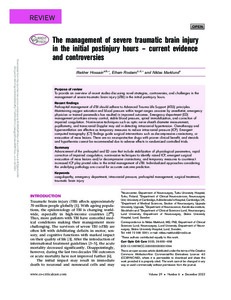The management of severe traumatic brain injury in the initial postinjury hours - current evidence and controversies
Hossain Iftakher; Rostami Elham; Marklund Niklas
https://urn.fi/URN:NBN:fi-fe2025082791733
Tiivistelmä
Purpose of review To provide an overview of recent studies discussing novel strategies, controversies, and challenges in the management of severe traumatic brain injury (sTBI) in the initial postinjury hours.
Recent findings Prehospital management of sTBI should adhere to Advanced Trauma Life Support (ATLS) principles. Maintaining oxygen saturation and blood pressure within target ranges on-scene by anesthetist, emergency physician or trained paramedics has resulted in improved outcomes. Emergency department (ED) management prioritizes airway control, stable blood pressure, spinal immobilization, and correction of impaired coagulation. Noninvasive techniques such as optic nerve sheath diameter measurement, pupillometry, and transcranial Doppler may aid in detecting intracranial hypertension. Osmotherapy and hyperventilation are effective as temporary measures to reduce intracranial pressure (ICP). Emergent computed tomography (CT) findings guide surgical interventions such as decompressive craniectomy, or evacuation of mass lesions. There are no neuroprotective drugs with proven clinical benefit, and steroids and hypothermia cannot be recommended due to adverse effects in randomized controlled trials.
Summary Advancement of the prehospital and ED care that include stabilization of physiological parameters, rapid correction of impaired coagulation, noninvasive techniques to identify raised ICP, emergent surgical evacuation of mass lesions and/or decompressive craniectomy, and temporary measures to counteract increased ICP play pivotal roles in the initial management of sTBI. Individualized approaches considering the underlying pathology are crucial for accurate outcome prediction.
Kokoelmat
- Rinnakkaistallenteet [27094]
